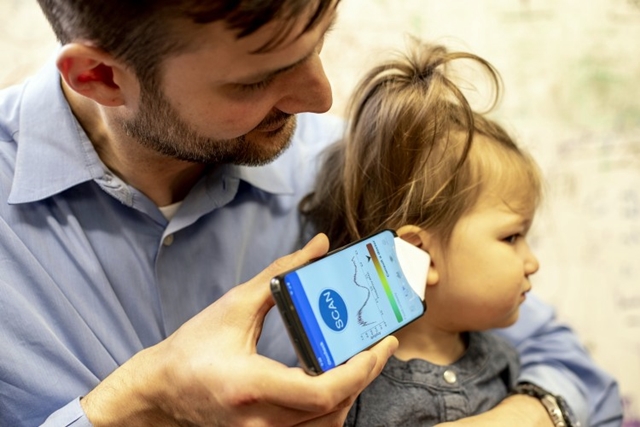
Co-author and medical school professor Randall Bly demonstrates using the ear fluid detection system (Dennis Wise, Univ of Washington)
16 May 2019. Computer scientists and medical researchers created a screening device for children’s ear infections with an app and algorithm on an ordinary smartphone. The team from University of Washington in Seattle describes the technology and tests of their device in yesterday’s issue of Science Translational Medicine (paid subscription required).
Several of the researchers, led by computer science professor Shyam Gollakota, also formed the start-up company Edus Health to commercialize the technology, for which the university filed for a provisional patent.
Gollakota and colleagues developed the system to help parents with infants and young children detect fluid build-up in the middle ear, behind the eardrum, a sign of ear infections. According to data cited by the authors, suspected ear infections are the leading reason for office visits to pediatricians. The problem covers two related ear conditions, acute otitis media where fluid builds up in the middle ear and becomes infected, and otitis media with effusion, a similar condition but without infection.
Acute otitis media is treatable with antibiotics, but if left untreated can lead to serious complications, including eardrum perforation. And while otitis media with effusion does not involve infections, this condition affecting up to 80 percent of children can interrupt their speech development, disrupt sleep, cause balance problems, and increase the likelihood of becoming infected.
Because these disorders happen to infants and young children, and the symptoms are often difficult to detect, parents have few options available other than taking the child to a doctor or outpatient clinic. Once at the doctor’s office, the tools for diagnosing these conditions are expensive and not always available. The authors note that doctors themselves are not happy with the current approach, and in conjunction with new clinical practice guidelines in 2016, American Academy of Otolaryngology recommended an easier method for parents to monitor fluid accumulations in children’s ears after the initial diagnosis.
Heeding that call, the Washington team devised a smartphone-based solution using a phone’s built-in speakers and microphone. The only other hardware added to the phone is a simple funnel cut from paper and attached to the speaker to direct test sounds into the child’s ears and reflected sounds back to the phone. The authors say this system can work with all iPhone versions, later Samsung Galaxy phones, and all other Android phones.
An app on the phone sends out continuous sounds like a bird chirping at a fixed frequency. The sounds sent from the phone then are reflected back from the ear canal, with the presence of fluid causing a characteristic audio pattern. That pattern is detected by an algorithm in the phone’s software, trained by tests with 53 children from 18 months to 17 years old.
The researchers tested the system with the same group at Seattle Children’s Hospital used for training the algorithm. Half of the children at the hospital were admitted for surgery to correct for recurring fluid build-up and ear infections, while the the remaining children had other conditions requiring hospitalization. Tests of the system with 98 ears on the 53 children show accurate detection of fluid 85 percent of the time, and found accurate detection of no fluid in 82 percent of cases, comparable to rates with standard and more expensive diagnostic equipment. Separate tests with children not involved in training the algorithm showed similar results.
The team also asked a group of parents to test the system with their children. The tests show parents could easily follow instructions to cut out and attach a paper filter, then use the smartphone and app to test for fluid in the middle ear. The results show in the 25 children’s ears tested, the parents accurately found the 6 ears with fluid and missed only 1 of the 19 ears that did not have fluid. The authors note that these usability tests with parents excluded children with more complex ear disorders.
The researchers believe the technology offers a useful device for parents and a way to reduce unnecessary office visits to pediatricians. “Designing an accurate screening tool on something as ubiquitous as a smartphone,” says Gollakota in a university statement, “can be game changing for parents as well as health care providers in resource limited regions.”
The following video demonstrates the smartphone-based system.
- Smartphone System Detects Diabetic Eye Disease
- Infographic – Mobile Phones in Emerging Economies
- Institute Developing Phone-Linked Graphene Sensors
- Smartphone App Measures Wounds, Tracks Healing
- Phone App Shown to Detect Serious Heart Attack
* * *

 RSS - Posts
RSS - Posts
You must be logged in to post a comment.